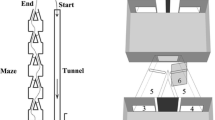Abstract
Three-spined sticklebacks of different ages use various simple strategies of exploratory behavior in an unfamiliar plus maze. These strategies involve a specific order of visits to the maze arms and they alternate during maze exploration. One of the strategies (touring) involves sequential visits to the arms during movement in a clockwise or counterclockwise direction. This strategy reduces the probability of returning to recently visited arms, but it does not require memorizing the sequence of arms visited. Another strategy consists of repeated shuttling between any two arms. Random transitions between arms are also observed. These transitions are difficult to explain within the concept of a specific simple strategy. An analysis of maze exploration strategies is proposed for comparative studies of behavioral organization in organisms of different taxonomic levels occupying different ecological niches.
Similar content being viewed by others
REFERENCES
Zyuganov, V.V., Family Gasterosteidae of the world fauna, in Fauna SSSR. Ryby (Fauna of the USSR: Fishes), Leningrad: Nauka, 1991, vol. 5, no. 1.
Mikheev, V.N., Neodnorodnost’ sredy i troficheskie otnosheniya u ryb (Heterogeneity of the Environment and Trophic Relationships in Fishes), Moscow: Nauka, 2006.
Nepomnyashchikh, V.A., Pankova, N.A., Osipova, E.A., et al., Spontaneous organization of animal behavior in unfamiliar surroundings, in XVIII Mezhdunarodnaya nauchno-tekhnicheskaya konferentsiya “Neiroinformatika-2016”. Lektsii po neiroinformatike (XVIII Int. Sci.-Eng. Conf. “Neuroinformatics-2016,” Lectures on Neuroinformatics), Moscow: Nats. Issled. Yad. Univ. “Mosk. Inzh.-Fiz. Inst.,” 2016, pp. 171–192.
Runyon, R.P., Nonparametric Statistics. A Contemporary Approach, Massachusetts: Addison–Wesley, 1977.
Balcı F., Ramey-Balcı P.A., Ruamps, P., Spontaneous alternation and locomotor activity in three species of marine crabs: green crab (Carcinus maenas), blue crab (Callinectes sapidus), and fiddler crab (Uca pugnax), J. Comp. Psychol., 2014, vol. 128, no. 1, pp. 65–73.
Benureau, F. and Oudeyer, P.Y., Diversity-driven selection of exploration strategies in multi-armed bandits, in Joint IEEE International Conference on Development and Learning and Epigenetic Robotics (ICDL-EpiRob), 2015, Providence: IEEE, 2015, pp. 135–142.
Dubreuil, D., Tixier, C., Dutrieux, G., and Edeline, J.M., Does the radial arm maze necessarily test spatial memory?, Neurobiol. Learn. Mem., 2003, vol. 79, no. 1, pp. 109–117.
Gottlieb, J., Oudeyer, P.Y., Lopes, M., and Baranes, A., Information-seeking, curiosity, and attention: computational and neural mechanisms, Trends Cognit. Sci., 2013, vol. 17, no. 11, pp. 585–593.
Grossman, L., Stewart, A., Gaikwad, S., et al., Effects of piracetam on behavior and memory in adult zebrafish, Brain Res. Bull., 2011, vol. 85, no. 1, pp. 58–63.
Hliňák, Z. and Krejčí, I., Spontaneous alternation behaviour in rats: kynurenic acid attenuated deficits induced by MK-801, Behav. Brain Res., 2006, vol. 168, no. 1, pp. 144–149.
Hölter, S.M., Tzschentke, T.M., and Schmidt, W.J., Effects of amphetamine, morphine and dizocilpine (MK-801) on spontaneous alternation in the 8-arm radial maze, Behav. Brain Res., 1996, vol. 81, no. 1, pp. 53–59.
Hughes, R.N. and Blight, C.M., Algorithmic behaviour and spatial memory are used by two intertidal fish species to solve the radial maze, Anim. Behav, 1999, vol. 58, no. 3, pp. 601–613.
Jones, M.A., Mason, G.J., and Pillay, N., Correlates of birth origin effects on the development of stereotypic behaviour in striped mice, Rhabdomys, Anim. Behav., 2011, vol. 82, no. 1, pp. 149–159.
Lennarz, R.C., The role of extramaze cues in spontaneous alternation in a plus-maze, Learn. Behav., 2008, vol. 36, no. 2, pp. 138–144.
Loh, E.A., Smith, A.M., and Roberts, D.C.S., Evaluation of response perseveration of rats in the radial arm maze following reinforcing and nonreinforcing drugs, Pharmacol., Biochem. Behav., 1993, vol. 44, no. 3, pp. 735–740.
Makukhin, K. and Bolland, S., Exploring the periphery of knowledge by intrinsically motivated systems, in Artificial Life and Computational Intelligence, Cham. Springer Int. Publ., 2015, pp. 49–61.
Maximino, C., de Brito, T.M., da Silva Batista, A.W., et al., Measuring anxiety in zebrafish: a critical review, Behav. Brain Res., 2010, vol. 214, no. 2, pp. 157–171.
Montgomery, K.C., The relation between exploratory behavior and spontaneous alternation in the white rat, J. Comp. Physiol. Psychol., 1951, vol. 44, no. 6, pp. 582–589.
Montgomery, K.C., Exploratory behavior and its relation to spontaneous alternation in a series of maze exposures, J. Comp. Physiol. Psychol., 1952, vol. 45, no. 1, pp. 50–57.
Mueller-Paul, J., Wilkinson, A., Hall, G., and Huber, L., Response-stereotypy in the jewelled lizard (Timon lepidus) in a radial-arm maze, Herpetol. Notes, 2012, vol. 5, no. 2, pp. 243–246.
Ragozzino, M.E., Pal, S.N., Unick, K., et al., Modulation of hippocampal acetylcholine release and spontaneous alternation scores by intrahippocampal glucose injections, J. Neurosci., 1998, vol. 18, no. 4, pp. 1595–1601.
Ramey, P.A., Teichman, E., Oleksiak, J., and Balci, F., Spontaneous alternation in marine crabs: invasive versus native species, Behav. Processes, 2009, vol. 82, no. 1, pp. 51–55.
Red’ko, V.G., Nepomnyashchikh, V.A., and Osipova, E.A., Model of fish exploratory behavior in mazes, Biol. Inspired Cognit. Archit., 2015, vol. 13, no. 1, pp. 9–16.
Roitblat, H.L., Tham, W., and Golub, L., Performance of Betta splendens in a radial arm maze, Anim. Learn. Behav., 1982, vol. 10, no. 1, pp. 108–114.
Sison, M. and Gerlai, R., Associative learning in zebrafish (Danio rerio) in the plus maze, Behav. Brain Res., 2010, vol. 207, no. 1, pp. 99–104.
ACKNOWLEDGMENTS
Financial support for the present work was provided by the Russian Foundation for Basic Research (projects no. 15-04-06379-a, 15-34-20416, and 15-04-03586-a).
Author information
Authors and Affiliations
Corresponding author
Additional information
Translated by S. Semenova
Rights and permissions
About this article
Cite this article
Pankova, N.A., Bolotovskiy, A.A., Levin, B.A. et al. Organization of Three-Spined Stickleback Gasterosteus aculeatus L. (Gasterosteidae: Pisces) Exploratory Behavior in a Plus Maze. Inland Water Biol 11, 485–491 (2018). https://doi.org/10.1134/S1995082918030136
Received:
Published:
Issue Date:
DOI: https://doi.org/10.1134/S1995082918030136




